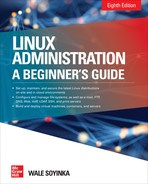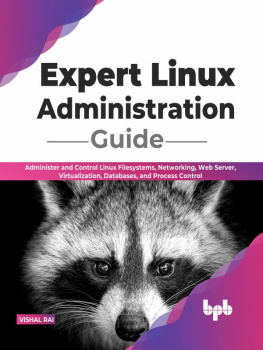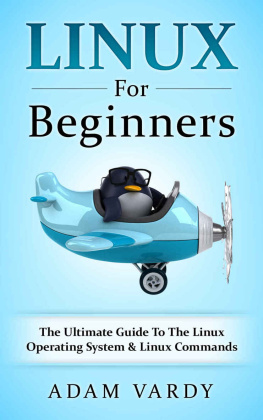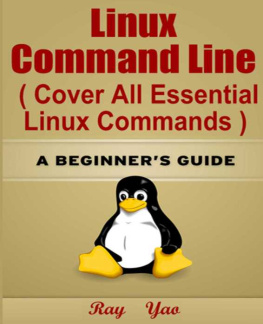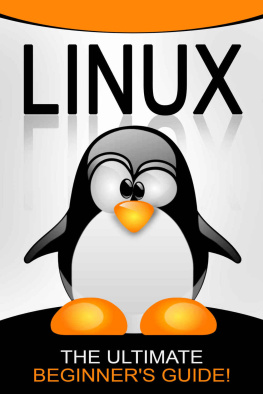Wale Soyinka - Linux Administration: A Beginners Guide
Here you can read online Wale Soyinka - Linux Administration: A Beginners Guide full text of the book (entire story) in english for free. Download pdf and epub, get meaning, cover and reviews about this ebook. year: 2020, publisher: McGraw-Hill, genre: Computer. Description of the work, (preface) as well as reviews are available. Best literature library LitArk.com created for fans of good reading and offers a wide selection of genres:
Romance novel
Science fiction
Adventure
Detective
Science
History
Home and family
Prose
Art
Politics
Computer
Non-fiction
Religion
Business
Children
Humor
Choose a favorite category and find really read worthwhile books. Enjoy immersion in the world of imagination, feel the emotions of the characters or learn something new for yourself, make an fascinating discovery.
- Book:Linux Administration: A Beginners Guide
- Author:
- Publisher:McGraw-Hill
- Genre:
- Year:2020
- Rating:3 / 5
- Favourites:Add to favourites
- Your mark:
- 60
- 1
- 2
- 3
- 4
- 5
Linux Administration: A Beginners Guide: summary, description and annotation
We offer to read an annotation, description, summary or preface (depends on what the author of the book "Linux Administration: A Beginners Guide" wrote himself). If you haven't found the necessary information about the book — write in the comments, we will try to find it.
Linux Administration: A Beginners Guide — read online for free the complete book (whole text) full work
Below is the text of the book, divided by pages. System saving the place of the last page read, allows you to conveniently read the book "Linux Administration: A Beginners Guide" online for free, without having to search again every time where you left off. Put a bookmark, and you can go to the page where you finished reading at any time.
Font size:
Interval:
Bookmark:


Copyright 2020 by McGraw Hill LLC. All rights reserved. Except as permitted under the United States Copyright Act of 1976, no part of this publication may be reproduced or distributed in any form or by any means, or stored in a database or retrieval system, without the prior written permission of the publisher, with the exception that the program listings may be entered, stored, and executed in a computer system, but they may not be reproduced for publication.
ISBN: 978-1-26-044171-0
MHID: 1-26-044171-7
The material in this eBook also appears in the print version of this title: ISBN: 978-1-26-044170-3, MHID: 1-26-044170-9.
eBook conversion by codeMantra
Version 1.0
All trademarks are trademarks of their respective owners. Rather than put a trademark symbol after every occurrence of a trademarked name, we use names in an editorial fashion only, and to the benefit of the trademark owner, with no intention of infringement of the trademark. Where such designations appear in this book, they have been printed with initial caps.
McGraw-Hill Education eBooks are available at special quantity discounts to use as premiums and sales promotions or for use in corporate training programs. To contact a representative, please visit the Contact Us page at www.mhprofessional.com.
Information has been obtained by McGraw Hill LLC from sources believed to be reliable. However, because of the possibility of human or mechanical error by our sources, McGraw Hill LLC, or others, McGraw Hill LLC does not guarantee the accuracy, adequacy, or completeness of any information and is not responsible for any errors or omissions or the results obtained from the use of such information.
TERMS OF USE
This is a copyrighted work and McGraw-Hill Education and its licensors reserve all rights in and to the work. Use of this work is subject to these terms. Except as permitted under the Copyright Act of 1976 and the right to store and retrieve one copy of the work, you may not decompile, disassemble, reverse engineer, reproduce, modify, create derivative works based upon, transmit, distribute, disseminate, sell, publish or sublicense the work or any part of it without McGraw-Hill Educations prior consent. You may use the work for your own noncommercial and personal use; any other use of the work is strictly prohibited. Your right to use the work may be terminated if you fail to comply with these terms.
THE WORK IS PROVIDED AS IS. McGRAW-HILL EDUCATION AND ITS LICENSORS MAKE NO GUARANTEES OR WARRANTIES AS TO THE ACCURACY, ADEQUACY OR COMPLETENESS OF OR RESULTS TO BE OBTAINED FROM USING THE WORK, INCLUDING ANY INFORMATION THAT CAN BE ACCESSED THROUGH THE WORK VIA HYPERLINK OR OTHERWISE, AND EXPRESSLY DISCLAIM ANY WARRANTY, EXPRESS OR IMPLIED, INCLUDING BUT NOT LIMITED TO IMPLIED WARRANTIES OF MERCHANTABILITY OR FITNESS FOR A PARTICULAR PURPOSE. McGraw-Hill Education and its licensors do not warrant or guarantee that the functions contained in the work will meet your requirements or that its operation will be uninterrupted or error free. Neither McGraw-Hill Education nor its licensors shall be liable to you or anyone else for any inaccuracy, error or omission, regardless of cause, in the work or for any damages resulting therefrom. McGraw-Hill Education has no responsibility for the content of any information accessed through the work. Under no circumstances shall McGraw-Hill Education and/or its licensors be liable for any indirect, incidental, special, punitive, consequential or similar damages that result from the use of or inability to use the work, even if any of them has been advised of the possibility of such damages. This limitation of liability shall apply to any claim or cause whatsoever whether such claim or cause arises in contract, tort or otherwise.
This book is dedicated to everyone who has contributed to open source technologies and ideals in one form or another. Without you, we would have nothing to write about.
Wale Soyinka is a system administrator, a DevOps/SecOps aficionado, an open source evangelist, and hacker.
He is also the author of several Linux, network, and Windows administration books, including Linux Administration: A Beginners Guide, Wireless Network Administration: A Beginners Guide, and Advanced Linux Administration.
When he is not marveling at his own culinary creations, Wale participates in discussions, projects, and ventures, usually focused on promoting and showcasing open source technologies and culture.
Buki Adeniji is an AWS cloud infrastructure consultant and seasoned telephony and telecomms professional who is extremely passionate about cloud computing, Linux, VoIP, and Asterisk, and has many global deployments under his belt. Buki has experience building and managing high-availability carrier-grade VoIP platforms and production infrastructure. He has led global teams that managed mission-critical cloud-based services, achieving 99.99 percent (four nines) service availability. Being a lifetime learner with advanced degrees in Telecomms, Business, and Project Management, as well as a number of AWS certifications, Bukis goal is to continue to excel at the boundaries of technology and innovation by using principles of ethnography and design thinking to develop technical solutions that address current and next-generation business needs. Above all, he is passionate about converting complex concepts and procedures into simple, concise, and executable steps. Buki currently resides in the Bay Area, where he is a passionate family man, as well as an active maker who participates in building and racing DIY self-driving model cars.
David Lane is a DevOps/SRE manager with 30 years of experience in open source solutions development and implementation for the government, corporations, and associations. He discovered Linux via the initial Slackware distribution in the late 1990s and has never looked back. Today, David helps companies transition to DevOps methodologies from traditional software development practices with open source tooling. When he is not helping companies, he is an amateur radio operator and emergency coordinator for ARES, where he espouses open source solutions for Software Defined Radio (SDR) and other methods of communication during a communications emergency.
I would like to thank Wendy Rinaldi, my editor, David Lane, Emily Walters, Patty Mon, Bart Reed, Tricia Lawrence, Claire Yee, and the McGraw-Hill crew for the magic that they do. Hats off to the folks at Cenveo for carrying us across the finish line.
I would never have gone far on this journey without the genius/work of thousands of strangers who contribute to FOSS as well the groundwork of individuals like Linus Torvalds and Richard Stallman. Thank you! Many thanks to Daniel A. for that first RedHat CD, the Berkeley UNIX Crew, Gene Schultz, Buki Adeniji, and Steve Shah for his foundational work.
I would like to thank Eldmar for my many adventures. I thank my mom and dad, my uncles, aunts, brothers, sisters, cousins, and my Bimpe. I am grateful to my friends for the gift of knowing them. I am forever thankful to Indian Baby and Hiromi who do little things that mean everything to me.
Font size:
Interval:
Bookmark:
Similar books «Linux Administration: A Beginners Guide»
Look at similar books to Linux Administration: A Beginners Guide. We have selected literature similar in name and meaning in the hope of providing readers with more options to find new, interesting, not yet read works.
Discussion, reviews of the book Linux Administration: A Beginners Guide and just readers' own opinions. Leave your comments, write what you think about the work, its meaning or the main characters. Specify what exactly you liked and what you didn't like, and why you think so.

